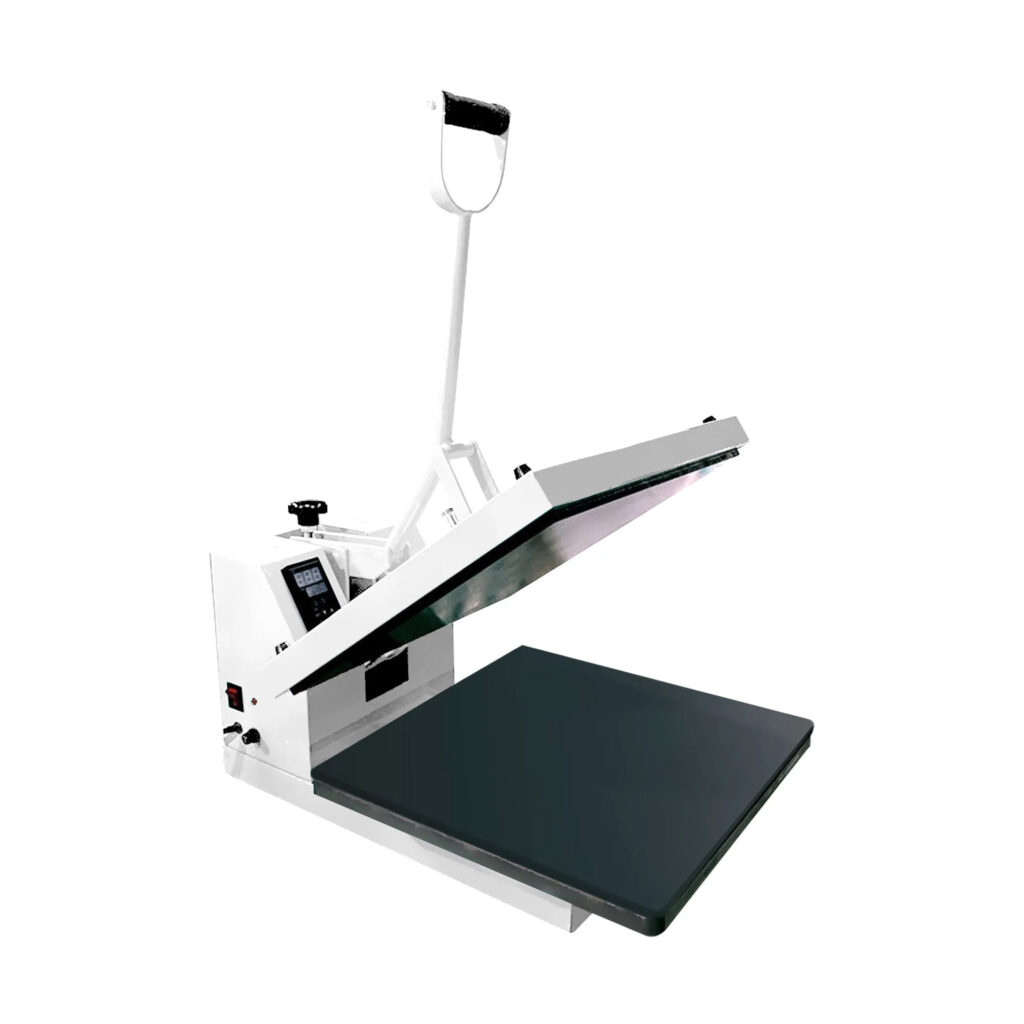To heat-press nylon bags, follow these steps:
- Gather necessary materials such as heat transfer vinyl and protective sheet
- Start the heat press machine and keep a temperature of 275 degrees Fahrenheit
- Pre-press the bag for 3 seconds
- Use a protective sheet to cover the design
- Place the bag on the platen of the press. Apply medium to high pressure
- Wait for 10-15 seconds. Peel the protective sheet and inspect the design
These are the quick steps to heat-press nylon bags. To know the process in detail and other important factors, keep reading the entire article.
Key Takeaways
- You can heat-press nylon bags by following six easy steps.
- Consider temperature, pressure, and material while heat-pressing nylon.
- When picking the right heat-press machine, size, style, and temperature will impact your decision.
- You can use a home iron to print on nylon bags.
How to Heat Press Nylon Bags
To heat press nylon bags, follow this step-by-step guide.
Step 1: Gather Your Materials and Equipment
To start the process, gather all the necessary materials and equipment:
- Heat press machine
- Nylon bag
- Heat transfer vinyl
- Protective sheet or Teflon cover sheet
- Pressing pillow (optional)
- Pre-press cloth
- Design or artwork
Step 2: Set Up Your Heat Press
- Power on your heat press machine and allow it to heat up.
- Start with a low temperature of 275 degrees Fahrenheit. Adjust these settings based on your specific heat press model and the manufacturer’s recommendations.
Step 3: Prepare the Nylon Bag
- To fix the bag’s wrinkles, place a pressing pillow inside the nylon bag. Alternatively, you can place the bag on the pillow on the machine’s lower platen.
- Now, pre-press the bag for 3 seconds. This helps in maintaining a smooth surface for the heat transfer.
Step 4: Apply the Heat Transfer Vinyl
- Position your design or artwork on the nylon bag.
- Cover the design with a protective sheet or Teflon cover sheet to prevent direct contact with the heat platen.
Step 5: Heat Pressing Process
- Place the nylon bag on the platen of the press.
- Close the machine and use medium to high pressure.
- Start the timer and wait for 10-15 seconds.
Step 6: Peel and Inspect
- Open the heat press when the timer goes off.
- Peel back the protective sheet from the design. Depending on the vinyl type, perform a hot or cold peel as recommended by the manufacturer.
- Inspect the design to ensure proper adhesion and vibrant colors.
Factors to Consider While Heat Pressing Nylon Bags
While heat-pressing nylon bags, focus on applying the right temperature and pressure. This will ensure you get the desired design outcome.
Temperature: Nylon is sensitive to heat, so it’s crucial to set the heat press at the appropriate temperature. Generally, a lower temperature setting is preferred to prevent scorching, melting, or distortion of the nylon fibers.
Begin the process with a low temperature and then increase it until you achieve the desired results. Typically, the recommended temperature for heat-pressing nylon starts from 275 degrees Fahrenheit.
Pressure: Proper pressure is essential for proper adhesion of the heat transfer material to the nylon surface. Too much pressure can cause the nylon to flatten or warp, while too little pressure can lead to inadequate bonding.
The ideal pressure will depend on the specific material you are using. For example, if you use heat transfer vinyl, apply light to medium pressure.
Along with this make sure that the DTF print is done properly. If the DTF transfer is not sticking then try to fix the issue as early as possible.
If you are not sure, follow the manufacturer’s guidelines for specific pressure settings. Also, you may conduct test runs to determine the ideal pressure for your specific nylon material.
Heat Press Machines for Nylon Bags
Choosing the right heat press machine can be sometimes tricky. But don’t worry, in this section, we discuss the critical factors that will help you choose the right equipment.

Size: The size of your transfer design will determine the size of the heat press you need. Options may range from small (6” by 6”) to large (20” by 25”). Based on your smallest and largest transfers, choose a machine that comes in the right size.
Style: Heat press machines come in two different types; clamshell and swing away. Clamshell presses close like a clam and are good for thinner materials.
On the other hand, swing away or ‘swingers’ presses have an upper plate that swings to the side. This allows for more precision and energy efficiency.
Clamshell heat presses have heating elements that open at a fixed angle of approximately 70 degrees. They are ideal for garments like T-shirts, sweaters, and thin flat substrates like keychains and photo panels.
Nylon bags are bulkier and have more texture compared to these flat substrates. Therefore, they need a swing-away heat press that allows more flexibility and space for effective heat transfer.
Temperature: Some machines have bimetallic thermometers, which are less accurate with around 5-10 degrees of difference. On the contrary, better machines use RTD probes, which only have a 2-degree difference.
Thinner plates (used in cheaper presses) lose heat faster than thicker ones. If you’re doing lots of pressing, a thin plate won’t keep the heat well and will waste your time.
However, higher-priced presses have better-quality plates that heat up quickly. So, you won’t have to waste time waiting for them to be ready for the next press.
Overall, you need to use higher-priced heat presses with RTD probes and better-quality plates for heat-pressing nylon bags. Firstly, nylon is a delicate fabric that can be damaged if you don’t use precise temperature. So, heat presses with RTD probes will be more beneficial.
Secondly, cheaper presses with thinner plates cannot retain heat properly. Therefore, heat presses with thicker plates are the ideal choice for effective heat transfer onto nylon.
Apart from heat press machines, make sure to invest in good quality printers. Epson printers can be a good option, but look for the ones you can convert to DTF.
Is It Possible to Use Home Iron to Print On a Nylon Bag?
Yes, it is possible to use a regular home iron for printing on a nylon bag. However, keep in mind that home irons have lower heat than professional heat presses.
You can easily print on nylon and cotton clothes if you have an iron, printable paper, and an inkjet printer.
Additionally, you’ll need a cutting machine if you want to cut vinyl. It is a good investment for various designs. So, you can personalize items like water bottles, signs, and glass easily.
For a practical guide, you can check out this helpful video.
Tips to Follow While Heat Pressing Nylon Bag
Whether you’re an experienced garment printer or a beginner, these tips are important to remember.
Choose Thin Heat Transfer Vinyl
Using thin heat transfer vinyl, like PU or matte, is best for printing on nylon. Avoid thick options like glitter vinyl, which requires higher heat and more time. Too much heat could even melt the nylon when pressing glitter vinyl.
| Product Name | Features |
| HTVRONT HTV Vinyl Rolls Heat Transfer Vinyl | Great stickinessEasy-to-cutEco-friendly |
| Flasoo 2 Rolls Black and White HTV Iron on Vinyl | Easy to weed & cutDurable & FlexibleWide applications |
Add a Barrier with Teflon or Parchment
It’s essential to place a Teflon sheet or parchment paper between the nylon garment and the heat press at all times. This protects both the machine and the design.
Also, it prevents the nylon from burning during printing. If you don’t have those, you can use the carrier sheet from the HTV as an alternative.

When Pressing Multiple Layers:
For multiple layers, it is ideal to apply two separate 5-second presses after completing each layer.
In general, avoid using more than three layers of HTV when printing. Additionally, ensure that the glitter vinyl is positioned as the uppermost layer.
If you use glitter vinyl at the bottom, the other HTV layers won’t stick properly. As a result, you’ll create a mess for your project.
You Need to Print on a Flat Surface:
When using a heat press for designs, it’s important to ensure the surface is flat. There might be situations where it’s not feasible, like when printing on a large nylon bag. In that case, simply place a pillow or a rolled-up shirt inside the bag, to flatten the printing surface.
Frequently Asked Questions (FAQs):
What Temperature Is Ideal for Heat Pressing Glitter Vinyl?
You can heat press glitter vinyl by setting a temperature of 300 to 320 °F for 15 to 20 seconds. Glitter vinyl is used for various fabrics such as cotton and polyester.
Are Nylon And Neoprene The Same?
No, neoprene and nylon are not the same. While neoprene is made from rubber, nylon comes from plastic. However, you can heat press on both nylon and neoprene.
What Fabrics Can I Heat Press?
You can heat-press almost any fabric you can think of. For example, nylon, cotton, and polyester are some of the most well-known fabrics. You can also heat press blends of these materials.
Closing Words
If you follow proper steps you can easily heat-press nylon bags. Make sure to pick the suitable machine and use the appropriate temperature and pressure. It will ensure you get the expected outcome from your design.




